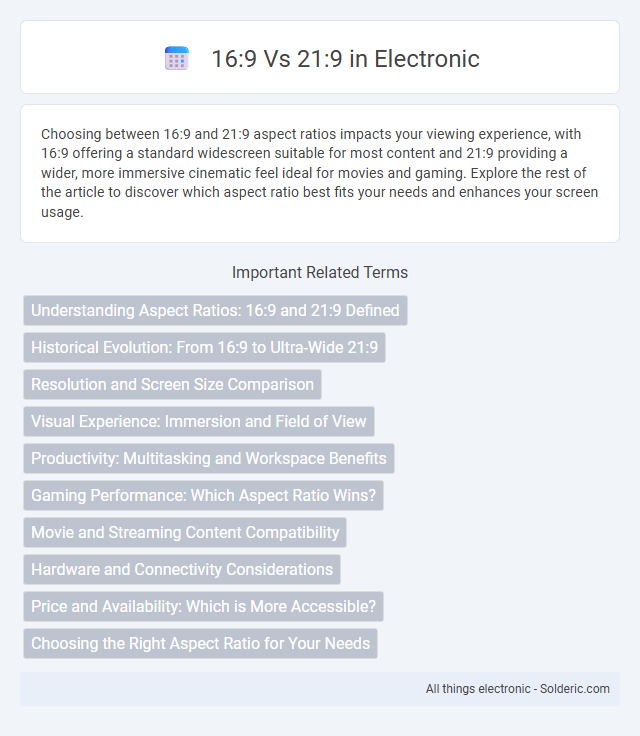Choosing between 16:9 and 21:9 aspect ratios impacts your viewing experience, with 16:9 offering a standard widescreen suitable for most content and 21:9 providing a wider, more immersive cinematic feel ideal for movies and gaming. Explore the rest of the article to discover which aspect ratio best fits your needs and enhances your screen usage.
Comparison Table
| Aspect Ratio | 16:9 | 21:9 |
|---|---|---|
| Screen Shape | Standard widescreen | Ultra widescreen |
| Common Uses | TVs, monitors, streaming video, gaming | Movies (cinematic), gaming, multitasking |
| Resolution Examples | 1920x1080, 1280x720 | 2560x1080, 3440x1440 |
| Field of View | Standard FOV, suitable for most content | Wider FOV, immersive experience |
| Compatibility | Universal compatibility | Limited support on some platforms |
| Content Display | Black bars on widescreen movies | Less letterboxing during movies |
| Price Range | More affordable and common | Generally more expensive |
Understanding Aspect Ratios: 16:9 and 21:9 Defined
The 16:9 aspect ratio, also known as widescreen, is the standard format for most televisions, monitors, and videos, providing a balanced display for everyday content. The 21:9 ratio, often called ultra-wide, offers a broader field of view ideal for immersive movie watching and enhanced multitasking on compatible screens. Your choice between 16:9 and 21:9 impacts how content fits and how much screen space you can utilize effectively.
Historical Evolution: From 16:9 to Ultra-Wide 21:9
The 16:9 aspect ratio became the global standard for HDTV and computer displays in the early 2000s due to its balance between width and height, optimizing compatibility across devices. The emergence of the ultra-wide 21:9 ratio followed, influenced by cinema's widescreen formats like Cinemascope, aiming to provide a more immersive, cinematic viewing experience for your movies and gaming. Transitioning from 16:9 to 21:9 reflects the industry's shift towards enhancing visual storytelling and multitasking capabilities on modern screens.
Resolution and Screen Size Comparison
The 16:9 aspect ratio typically features resolutions like 1920x1080 (Full HD) and 3840x2160 (4K UHD), offering a balanced screen size ideal for gaming and standard video content. In contrast, the 21:9 aspect ratio provides a wider field of view with resolutions such as 2560x1080 and 3440x1440, enhancing immersive experiences in movies and multitasking by expanding horizontal screen real estate. Choosing between these ratios impacts your display's width and height, where 21:9 delivers a broader screen size suited for cinematic viewing and productivity without sacrificing vertical resolution.
Visual Experience: Immersion and Field of View
The 16:9 aspect ratio offers a balanced visual experience suitable for most standard content, providing a natural field of view that fits typical screens and broadcasts. In contrast, the 21:9 ratio delivers a wider field of view, enhancing immersion especially for cinematic films and ultra-wide gaming, creating a more encompassing and panoramic experience. Your choice between these ratios impacts how much peripheral vision and engagement you get, with 21:9 excelling in depth and breadth of visual immersion.
Productivity: Multitasking and Workspace Benefits
The 21:9 aspect ratio offers a wider workspace compared to 16:9, enabling enhanced multitasking by allowing multiple windows to be open side by side without overlapping. Ultrawide monitors with 21:9 can improve productivity by reducing the need for multiple monitors, minimizing bezel interruptions and streamlining workflow. In contrast, 16:9 screens provide less horizontal space, limiting simultaneous task management and reducing overall workspace efficiency.
Gaming Performance: Which Aspect Ratio Wins?
The 16:9 aspect ratio remains the standard for gaming due to widespread game optimization and compatibility, delivering consistent performance and smooth gameplay across most titles. In contrast, 21:9 ultra-wide monitors provide a more immersive field of view, enhancing peripheral vision in games that support this ratio but may demand more GPU power, potentially impacting frame rates. Your choice depends on balancing immersive experiences with stable performance, where 16:9 prioritizes compatibility and 21:9 emphasizes expanded visuals.
Movie and Streaming Content Compatibility
The 16:9 aspect ratio is the standard for most movies and streaming platforms, ensuring content displays without black bars or cropping on devices such as TVs and laptops. In contrast, 21:9, also known as ultrawide, better accommodates cinematic films shot in anamorphic formats, offering a more immersive widescreen experience by minimizing letterboxing. Streaming services like Netflix and Disney+ primarily optimize for 16:9, with 21:9 support providing enhanced viewing for select film genres and dedicated ultrawide monitors.
Hardware and Connectivity Considerations
When comparing 16:9 and 21:9 aspect ratios, hardware compatibility plays a crucial role in your choice, as 21:9 ultrawide monitors require specific graphics card support and may need DisplayPort or USB-C connections for optimal performance. Most modern GPUs handle 16:9 outputs natively with HDMI or standard DisplayPort, ensuring broad compatibility with existing devices. Ensuring your hardware and connectivity options align with the ultrawide format prevents resolution scaling issues and maximizes display efficiency for your setup.
Price and Availability: Which is More Accessible?
16:9 displays are generally more affordable and widely available due to their standard use in TVs, monitors, and laptops, making them accessible for most budgets. 21:9 ultrawide screens tend to be pricier and less common, often sought after for specialized uses like gaming and professional video editing. Your choice depends on balancing budget constraints with the need for immersive viewing or productivity benefits.
Choosing the Right Aspect Ratio for Your Needs
Selecting the appropriate aspect ratio depends on intended usage and viewing experience preferences. The 16:9 ratio is ideal for general multimedia, gaming, and streaming, offering compatibility with most content and devices. The 21:9 ratio excels in cinematic viewing and multitasking, providing a wider field of view and enhanced immersion, especially for ultrawide monitors and movie enthusiasts.
16:9 vs 21:9 Infographic

 solderic.com
solderic.com